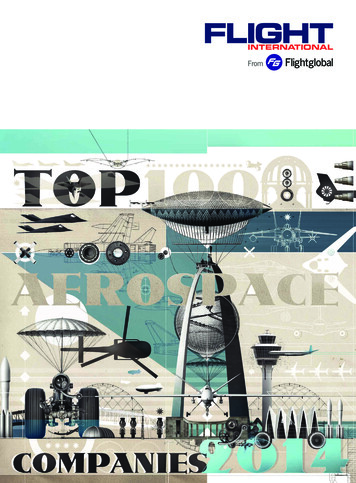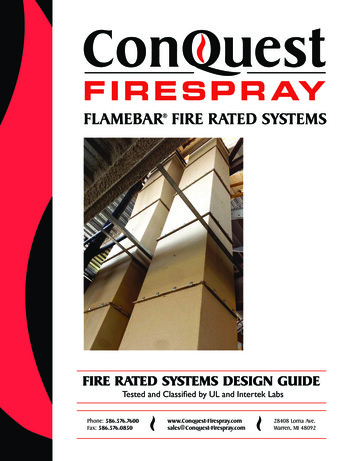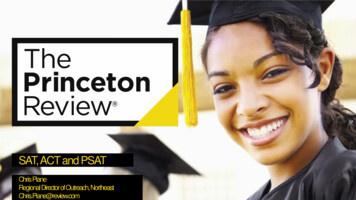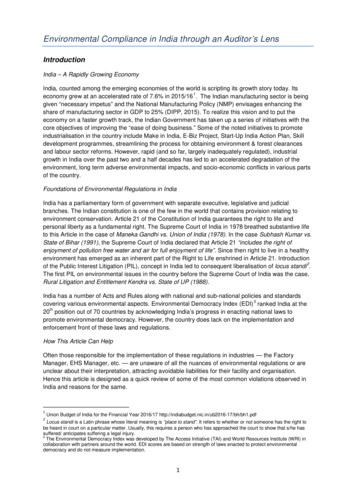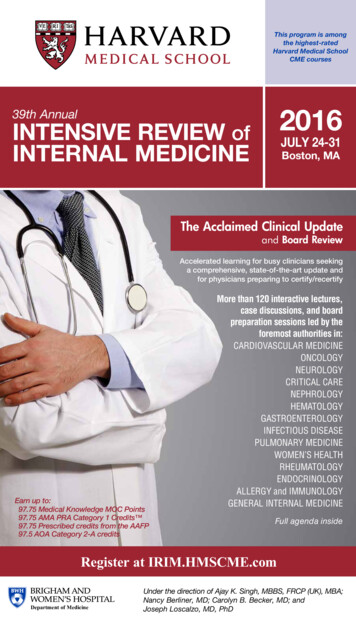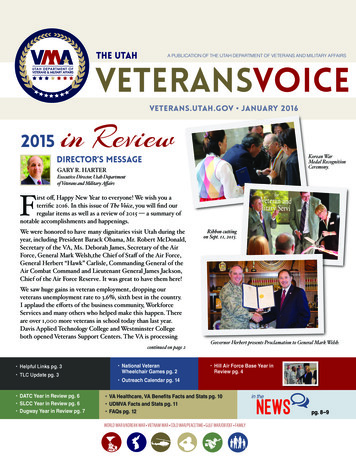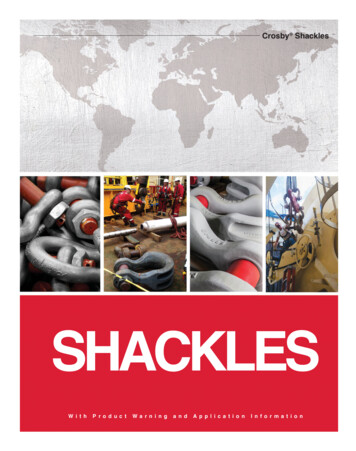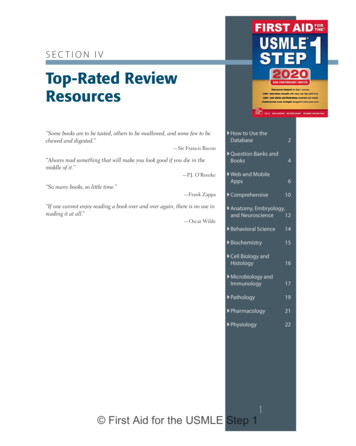
Transcription
SECTION IVTop-Rated ReviewResources“Some books are to be tasted, others to be swallowed, and some few to bechewed and digested.” How to Use theDatabase2 Question Banks andBooks4—P.J. O’Rourke Web and MobileApps6—Frank Zappa Comprehensive10—Sir Francis Bacon“Always read something that will make you look good if you die in themiddle of it.”“So many books, so little time.”“If one cannot enjoy reading a book over and over again, there is no use inreading it at all.”—Oscar Wilde Anatomy, Embryology,and Neuroscience12 Behavioral Science14 Biochemistry15 Cell Biology andHistology16 Microbiology andImmunology17 Pathology19 Pharmacology21 Physiology22 First Aid for the USMLE Step 1FAS1 2019 23 BookRev ONLINE.indd 1111/8/19 6:49 AM
2SEC TION IVTop-Rated Review Resources HOW TO USE THE DATABASEThis section is a database of top-rated basic science review books, sampleexamination books, websites, apps, and commercial review courses thathave been marketed to medical students studying for the USMLE Step 1.At the end of the section is a list of publishers and independent bookstoreswith addresses and phone numbers. For each recommended resource, welist (where applicable) the Title, the First Author (or editor), the SeriesName (where applicable), the Current Publisher, the Copyright Year,the Number of Pages, the ISBN, the Approximate List Price, the Formatof the resource, and the Number of Test Questions. We also includeSummary Comments that describe their style and overall utility forstudying. Finally, each recommended resource receives a Rating. Withineach section, resources are arranged first by Rating and then alphabeticallyby the first author within each Rating group.A letter rating scale with six different grades reflects the detailed studentevaluations for Rated Resources. Each rated resource receives a rating asfollows:A Excellent for boards review.AA Very good for boards review; choose among the group.B BGood, but use only after exhausting better resources.B Fair, but there are many better resources in the discipline; or lowyield subject material.The Rating is meant to reflect the overall usefulness of the resource inhelping medical students prepare for the USMLE Step 1. This is based on anumber of factors, including: The costThe readability of the textThe appropriateness and accuracy of the materialThe quality and number of sample questionsThe quality of written answers to sample questionsThe quality and appropriateness of the images and illustrationsThe quality of the user interface and learning experience, for web andmobile apps The length of the text (longer is not necessarily better) The quality and number of other resources available in the samediscipline The importance of the discipline for the USMLE Step 1Please note that ratings do not reflect the quality of the resources forpurposes other than reviewing for the USMLE Step 1. Many books with First Aid for the USMLE Step 1FAS1 2019 23 BookRev ONLINE.indd 211/8/19 6:49 AM
Top-Rated Review ResourcesSEC TION IV3lower ratings are well written and informative but are not ideal for boardspreparation. We have not listed or commented on general textbooksavailable in the basic sciences.Evaluations are based on the cumulative results of formal and informalsurveys of thousands of medical students at many medical schools across thecountry. The summary comments and overall ratings represent a consensusopinion, but there may have been a broad range of opinion or limitedstudent feedback on any particular resource.Please note that the data listed are subject to change in that: Publisher and app store prices change frequently. Retail and online bookstores may set their own prices. New editions and app versions come out frequently, and the quality ofupdating varies. The same book may be reissued through another publisher.We actively encourage medical students and faculty to submit their opinionsand ratings of these basic science review materials so that we may updateour database. In addition, we ask that publishers and authors submit forevaluation review copies of basic science review books, including neweditions and books not included in our database. We also solicit reviewsof new books, mobile apps, websites, flash cards, and commercial reviewcourses.Disclaimer/Conflict of Interest StatementNone of the ratings reflects the opinion or influence of the publisher. Allerrors and omissions will gladly be corrected if brought to the attention ofthe authors through our blog at www.firstaidteam.com. Please note thatUSMLE-Rx and the entire First Aid for the USMLE series are publicationsby certain authors of First Aid for the USMLE Step 1; the following ratingsare based solely on recommendations from the student authors of First Aidfor the USMLE Step 1 as well as data from the student survey and feedbackforms. First Aid for the USMLE Step 1FAS1 2019 23 BookRev ONLINE.indd 311/8/19 6:49 AM
4SEC TION IVTop-Rated Review Resources QUESTION BANKS AND BOOKSA UWorld QbankUWorld 249 – 749 Test/2400 qwww.uworld.comQuestions demand multistep reasoning and are often more difficult than those on the actual Step 1exam. O ffers detailed explanations with figures and tables. Features a number of test customizationand analysis options. Users can see cumulative results both over time and compared to other testtakers. In addition to a desktop version, it can be accessed through iOS or Android mobile apps.ANBME Practice Exams 60 Test/200 qNational Board of Medical tmlThe official practice exams published by the NBME are comprised of retired Step 1 questions. NBMEresearch found that they show a “moderate correlation” with actual Step 1 performance. The exams willshow you which questions you answered incorrectly, but they will not show any explanations. You willalso not be able to review correctly answered questions. Students generally use these as rough gaugesof their score progression over their study time. Note that you can sign up to for an in-person practiceexam for an additional 75 to be taken at Prometric, for students who want to practice the logistics ofexam day.A–AMBOSS 9– 365 Test/3500 qAmbosswww.amboss.comIntegrated question bank for Step 1 and Step 2 CK exams with an additional interactive online library ofmedical resources. Contains numerous illustrations within the clinical vignettes. Allows for the selec tionof questions by difficulty level. Includes personalized study plan. Free trial available, accessible throughiOS or Android mobile apps.A–USMLE-Rx QmaxUSMLE-Rx 89– 339 Test/2300 qwww.usmle-rx.comOffers Step 1–style questions accompanied by thorough explanations. Omits obscure material and distills high yield information. Each explanation includes references from First Aid. However, the proportion of questions covering a given subject area does not always reflect the actual exam’s relativeemphasis. Question stems occasionally rely on “buzzwords.” Most useful to help memorize First Aidfacts. Provides detailed performance analyses. Free trial available, accessible through iOS or Androidmobile apps. First Aid for the USMLE Step 1FAS1 2019 23 BookRev ONLINE.indd 411/8/19 6:49 AM
B Kaplan QbankKaplan SEC TION IV5 99– 349 Test/2100 qwww.kaptest.comCovers most content found on Step 1, but sometimes emphasizes recall of low-yield details ratherthan integrative problem-solving skills. Test content and performance feedback can be organized byboth organ system and discipline. Includes detailed explanations of all answer choices. Users cansee cumulative results both over time and compared to other test takers. Accessible through iOS orAndroid mobile apps.BBoardVitals 59– 179 Test/1750 qwww.boardvitals.comComprehensive question bank modeled closely after the format of the Step 1. Covers all subject areasand includes explanations for each answer choice. Users can create custom exams and compare theirperformance to national averages. Contains fewer image-based questions compared to similar platforms.BKaplan USMLE Step 1 Qbook 50 Test/850 qKaplanKaplan, 2017, 468 pages, ISBN 9781506223544Consists of over 850 exam-like questions organized by the traditional basic science disciplines. Similarto the Kaplan Qbank, and offers USMLE-style questions with clear, detailed explanations; however,lacks classic images typically seen on the exam. Also includes access to a sample online question bankand a guide on test-taking strategies.BPastest 79– 249 Test/2100 qwww.pastest.comQuestions appear to be simpler than board-style questions, with many first- and second-order questions.Explanations are accompanied by references to First Aid and short video clips to reinforce information.Accessible through iOS or Android mobile apps.BTrueLearn Review 159– 399 Test/2200 qwww.truelearn.comIncludes over 2200 USMLE-style practice questions with topics mapped to the NBME blueprint. Usesnational benchmarking to show students where they stand in comparison to peers. First Aid for the USMLE Step 1FAS1 2019 23 BookRev ONLINE.indd 511/8/19 6:49 AM
6SEC TION IVTop-Rated Review Resources WEB AND MOBILE APPSAAnkiFree Flash cardswww.ankisrs.netFlash card–making resource designed for retention of facts through spaced repetition. Free access viadesktop and smartphone for Windows, Mac, and Android. The iOS app must be purchased for 25.Available in different languages.ABoards and Beyond 19– 249 Reviewwww.boardsbeyond.comIncludes over 400 videos averaging 26 minutes each, covering the breadth of Step 1 material. Membership includes access to the companion books as PDFs. A collection of videos is offered as free samples on the website. Also includes over 1300 practice questions.APhyseo 30– 150 Reviewwww.physeo.comOnline review containing 32 hours of review videos covering physiology. Accessible via website or mobile app. Includes a supplemental full-color PDF textbook. Videos are concise and focus on highyield material, and board-style practice questions are included after each topic to help solidify understanding. Similar structure to Pathoma, but with physiology focus.ASketchyMedical 99– 369 Reviewwww.sketchymedical.comVideo library of narrated lectures with thorough explanations that present microbiology, pharmacology, and pathology in a memora ble style. Access to the entire gram-positive cocci section is free atsignup. Additional content can be purchased on a subscription basis.A–Cram Fighter 29– 159 Study planwww.cramfighter.comHelps organize a study schedule. Highly flexible with customizable settings. Supports more than 650of the most popular books, video lectures, question banks, and flash cards. Mobile apps available foriOS and Android.A–First Aid Step 1 Express 69– 299 Review/Testwww.usmle-rx.comMore than 80 hours of high-yield videos explaining material from First Aid for the USMLE Step 1.Videos include more than 600 extra images and multimedia clips. Step-by-step analysis of USMLE-stylequestions with each video. Subscription includes a color workbook with over 200 pages.B First Aid Step 1 Flash Facts 29– 149 Flash cardswww.usmle-rx.comAccess to 12,000 flash cards with intelligent spaced repetition integrated with First Aid for theUSMLE Step 1, of which 3500 are case based. Updated each year to reflect the newest edition of thebook; students can access the past 3 editions’ worth of flash cards. Searchable by organ system, discipline, and topic. First Aid for the USMLE Step 1FAS1 2019 23 BookRev ONLINE.indd 611/8/19 6:49 AM
B SEC TION IVMedbullets7Free Review/Test/1000 qwww.medbullets.comFree online learning and collaboration community for students preparing for their exams. Supplements medical school coursework and Step 1 studying with simplified, to-the-point online searchplatform that is best used as a reference. Recently added premium content for 80- 250 includes anonline question bank and adaptive learning system.B Medical School PathologyFree Reviewwww.medicalschoolpathology.comOffers lectures and slides based on the Robbins Pathology textbook. Lectures can be downloaded.B OnlineMedEdFree Reviewwww.onlinemeded.orgA video lecture series covering primarily clinical science material, with recent addition of biochemistry, cell biology, and immunology topics. Video access is free with registration. A subscription of 10 70/month gains access to ad-free videos, lecture notes, flash cards, question bank, and downloadableaudio lectures.B Osmosis 179– 279 Testwww.osmosis.orgWeb platform that includes exam study scheduling tool, 27,000 variable quality multiple choice questions, flash cards with spaced repetition, and 3000 curated concept cards with videos, memory anchors, and reference articles. Includes a curriculum analysis and search engine, collaboration featuresfor study groups, and a mobile app with quizzes and videos.B USMLE Step 1 Mastery 2– 10 Test/1400 on bank accessible through website or via free mobile app. Covers all USMLE topics andincludes vignettes, images, and mnemonics. Question formatting is generally less representative ofactual USMLE questions compared with other widely used question banks. Mobile app containssupplemental flash cards for integrated learning.B WebPath: The Internet Pathology LaboratoryFree Review/Test/1300 qwebpath.med.utah.eduFeatures more than 2700 gross and microscopic images, clinical vignette questions, and case studies.Includes nine general pathology exams and 11 system-based pathology exams with approximately1300 questions. Also features 170 questions associated with images. Questions are useful for reviewingboards content but are typically untimed, easier, and shorter. No multimedia practice questions. Notregularly updated with regard to high-yield Step 1 material.BBlue HistologyFree Review/Testwww.lab.anhb.uwa.edu.au/mb140Provides access to 400 histologic images with thorough explanations. Images searchable by topic,stain, keyword. Website also contains multiple choice practice questions. First Aid for the USMLE Step 1FAS1 2019 23 BookRev ONLINE.indd 711/8/19 6:49 AM
8SEC TION IVBTop-Rated Review Resources Digital Anatomist Project: Interactive AtlasesFree ReviewUniversity of Washingtonda.si.washington.edu/da.htmlContains an interactive neuroanatomy course along with a three-dimensional atlas of the brain, thorax,and knee. Atlases have computer-generated images and cadaver sections. Each atlas also has a quiz inwhich users identify structures in the slide images. However, questions do not focus on high-yield anatomy for Step 1.BDr. Najeeb Lectures 99 Reviewwww.drnajeeblectures.comHundreds of hours of video lectures covering basic medical sciences and clinical medicine with thousands of hand-drawn illustrations and mnemonics. Website provides mobile video support on smartphones and tablets. Free lectures accessible at BFirecrackerFirecracker Inc. 39– 660 Review/Test/2800 qfirecracker.lww.comLearning platform divided into modules. The Step 1 module is divided into organ systems and includes review of preclinical lecture material, periodic quizzes on flagged reviewed material, andUSMLE-style questions in interface simulating the actual exam. Contains page references to First Aidfor the USMLE Step 1 and high-yield diagrams from various textbooks. Users can grade how well theyremember the quiz answers (1–5), which allows the program to customize future quizzes. Featuresdetailed performance analysis and a calendar for personalized study plans. Accessible on all smartphones and tablets. Comprehensive; best if started early in preclinical years.BKISSPrep 99– 135 Reviewwww.kissprep.comOnline lecture videos focused on select subjects from the Step 1 exam. Focuses on harder-to-learncontent and teaches it in a simple, easy-to-understand manner. Quizzes and other interactive tools areavailable to help with knowledge retention. Not all Step 1 content is covered on this platform.BLecturio 50– 300 Review/Test/2150 qwww.lecturio.comOnline platform for comprehensive exam preparation, including over 250 hours of lectures, a flashcard deck, quizzes, and a question bank. Organized by subject matter and allows users to customizetheir learning experience. Some content may be beyond the scope of the exam and better suited formedical school coursework. Lectures and quizzes may be accessed for free. iOS and Android apps areavailable.BMemorang 19– 239 Flash cardsMemorang Inc.www.memorangapp.comPlatform utilizing spaced repetition, available both in website and app form. Utilizes custom and/orpremade flash card “study sets” derived from 15,000 flash cards that focus on specific subject areasand are then tested via various games and quizzing methods. Free 7-day trial, or monthly/annualmembership. First Aid for the USMLE Step 1FAS1 2019 23 BookRev ONLINE.indd 811/8/19 6:49 AM
BPicmonic SEC TION IV9 25– 480 Reviewwww.picmonic.comHelpful resource for visual learners. Unique images and stories with daily quizzes and spaced repetition. Contains 1400 images and includes study guides, webinars, and infographics that help cover15,000 facts of Step 1 material. Offered via both web and mobile platforms.B–Radiopaedia.orgFree Cases/Testwww.radiopaedia.orgA user-friendly website with thousands of well-organized radiology cases and articles. Encyclopedia entries contain high-yield bullet points of anatomy and pathology. Images contain detailed descriptionsbut no arrows to demarcate findings. Quiz mode allows students to make a diagnosis based on radiographic findings. Content may be too broad for boards review but is a good complement to classes andclerkships.B–The Pathology GuyFriedlanderFree Reviewwww.pathguy.comContains extensive but poorly organized information on a variety of fundamental concepts in pathology.A high-yield summary intended for USMLE review can be found at www.pathguy.com/meltdown.txt,but the information given is limited by a lack of images and frequent digressions. First Aid for the USMLE Step 1FAS1 2019 23 BookRev ONLINE.indd 911/8/19 6:49 AM
10SEC TION IVTop-Rated Review Resources COMPREHENSIVEAFirst Aid for the Basic Sciences: General PrinciplesLe 55 ReviewMcGraw-Hill, 2019, 816 pages, ISBN 9781260143676Comprehensive review of the basic sciences covered in year 1 of medical school. Similar to the firstpart of First Aid, organized by discipline, and includes hundreds of color images and tables. Best ifstarted with first-year coursework and then used as a reference during boards preparation.AFirst Aid Cases for the USMLE Step 1Le 50 CasesMcGraw-Hill, 2018, 496 pages, ISBN 9781260143133A recently updated series of hundreds of high-yield cases organized by organ system. Each case features a clinical vignette with relevant images, followed by questions and short, high-yield explanations.Offers coverage of many frequently tested concepts, and integrates subject matter in the discussion ofthe vignette. Helpful in reviewing material outlined in First Aid for the USMLE Step 1.A–First Aid for the Basic Sciences: Organ SystemsLe 72 ReviewMcGraw-Hill, 2017, 912 pages, ISBN 9781259587030A comprehensive review of the basic sciences covered in year 2 of medical school. Similar to the second part of First Aid, organized by organ system, and includes hundreds of color images and tables.Each organ system contains discussion of embryology and anatomy, physiology, pathology, and pharmacology. Best if started with second-year coursework and then used as a reference during boardspreparation.A–Crush Step 1: The Ultimate USMLE Step 1 ReviewO’Connell 45 ReviewElsevier, 2017, 704 pages, 9780323481632Detailed, text-heavy review book with practice questions included. Coverage of many high-yield topicsbut includes some outdated information. Best if used with coursework, but also recommended as asupplemental reference for boards review. Limited student feedback.A–Cracking the USMLE Step 1Princeton Review 45 ReviewPrinceton Review, 2013, 832 pages, ISBN 9780307945068Comprehensive review book with hundreds of illustrations, charts, and diagrams along with 2 fulllength practice tests with detailed answer explanations available online. Limited student feedback.B USMLE Step 1 Secrets in ColorBrown 43 ReviewElsevier, 2016, 800 pages, ISBN 9780323396790Clarifies difficult concepts in a concise, readable manner. Uses a case-based format and integratesinformation well. High-quality clinical images. Complements other boards study resources, with afocus on understanding preclinical fundamentals rather than on rote memorization. Slightly lengthyfor last-minute studying. First Aid for the USMLE Step 1FAS1 2019 23 BookRev ONLINE.indd 1011/8/19 6:49 AM
B SEC TION IVStep-Up to USMLE Step 1 2015Jenkins11 50 ReviewLippincott Williams & Wilkins, 2014, 528 pages, ISBN 9781469894690An organ system–based review text with clinical vignettes that is useful for integrating the basic sciences covered on Step 1. Composed primarily of outlines, charts, tables, and diagrams. Limited scopeof material covered. Includes access to a sample online question bank.B USMLE Step 1 Lecture Notes 2018Kaplan 330 ReviewKaplan Medical, 2018, 2700 pages, ISBN 9781506221229Extremely comprehensive review of Step 1 topics through videos and lecture notes. Split into individual sections covering pathology, pharmacology, physiology, biochemistry and medical genetics, immunology and microbiology. Generally best used to fill gaps in understanding and to review unfamiliartopics that one has not come across, and therefore the notes are commonly used by foreign medicalgraduates. Some sections are quite detailed and go beyond the scope of the Step 1 exam.B USMLE Images for the Boards: A Comprehensive Image-Based ReviewTully 42 ReviewElsevier, 2012, 296 pages, ISBN 9781455709038Contains more than 300 color images of content likely to be tested on the Step 1. Contains a widevariety of images including ECGs and radiographic studies. Some images may be low yield for boardsstudying, but still excellent as a supplement to preclinical courses.BUSMLE Step 1 Made Ridiculously SimpleCarl 30 Review/Test1000 qMedMaster, 2017, 416 pages, ISBN 9781935660224Concise, succinct text. Online access to more than 1000 practice questions. Uses a table and chartformat organized by subject, but some charts are poorly labeled. Consider as an adjunct to more comprehensive sources.BmedEssentials for the USMLE Step 1Manley 55 ReviewKaplan, 2012, 588 pages, ISBN 9781609780265A comprehensive review divided into general principles and organ systems, organized using highyield tables and figures. Helpful for visual learners, but can be overly detailed and time consuming.Includes color images in the back along with a monthly subscription to online interactive exercises,although these are of limited value for Step 1 preparation. Comes with a free mobile version. First Aid for the USMLE Step 1FAS1 2019 23 BookRev ONLINE.indd 1111/8/19 6:49 AM
12SEC TION IVTop-Rated Review Resources ANATOMY, EMBRYOLOGY, AND NEUROSCIENCEA–High-Yield Gross AnatomyDudek 43 ReviewLippincott Williams & Wilkins, 2014, 320 pages, ISBN 9781451190236A good review of gross anatomy with some clinical correlations. Contains color clinical photos andwell-labeled, high-yield radiographic images, but often goes into excessive detail that is beyond thescope of the boards.A–Clinical Anatomy Made Ridiculously SimpleGoldberg 30 ReviewMedMaster, 2016, 175 pages, ISBN 9780940780972An easy-to-read text offering simple diagrams along with numerous mnemonics, helpful charts, andamusing associations. The humorous style has variable appeal to students, so browse the content beforepurchasing. Offers good coverage of selected topics. Includes a CD-ROM atlas of normal radiographicanatomy. Best if used during coursework. Includes more detail than typically tested on Step 1.B High-Yield EmbryologyDudek 56 ReviewLippincott Williams & Wilkins, 2013, 176 pages, ISBN 9781451176100A concise review of a relatively less-tested subject. Offers excellent organization with clinical correlations. Includes a high-yield list of embryologic tissue origins and USMLE-style case studies after eachchapter. May not be suitable for dedicated Step 1 studying.B High-Yield NeuroanatomyFix 40 Review/Test/50 qLippincott Williams & Wilkins, 2015, 208 pages, ISBN 9781451193435An easy-to-read, straightforward format with excellent diagrams and illustrations. Features a useful atlasof brain and spinal cord images, a glossary of important terms, and an appendix of neurologic lesions.Overall, a great resource and quick read, but more detailed than what is required for Step 1.B Anatomy—An Essential TextbookGilroy 48 Text/Test/400 qThieme, 2017, 528 pages, ISBN 9781626234390A thorough, visually appealing approach to learning anatomy. Contains over 650 colorful, helpful illustrations. Presents material in bullet-point format and tables. Includes over 160 clinical correlates and400 USMLE-style questions, with the opportunity to complete practice questions online.B Netter’s Anatomy Flash CardsHansen 40 Flash cardsSaunders, 2018, 688 flash cards, ISBN 9780323530507Netter’s illustrations in a question/answer column format that allows for self-testing. Each card includes commentary on the structures with a clinical correlation. More effective as a supplementto coursework, and much too detailed for boards preparation. Lack of embryology correlates limitsStep 1 usefulness. Includes online access with additional bonus cards and more than 400 multiplechoice questions. Note: an iOS app has a similar cost and additional functionality. First Aid for the USMLE Step 1FAS1 2019 23 BookRev ONLINE.indd 1211/8/19 6:49 AM
B SEC TION IVCrash Course: AnatomyStenhouse13 45 ReviewElsevier, 2015, 288 pages, ISBN 9780723438540Part of the Crash Course review series for basic sciences, integrating clinical topics. Offers two-colorillustrations, handy study tools, and Step 1 review questions. Contains an up-to-date self-assessmentsection. Provides a solid review of anatomy for Step 1. Best if started early.BBRS EmbryologyDudek 56 Review/Test/220 qLippincott Williams & Wilkins, 2014, 336 pages, ISBN 9781451190380An outline-based review of embryology that is typical of the BRS series. Offers a good review andincludes much more detail than is required for Step 1. A discussion of congenital malformations isincluded at the end of each chapter, along with over 220 USMLE-style questions with answers andexplanations. The comprehensive exam at the end of the book is high yield. Includes access to asearchable online text on the free companion website, which also features interactive quizzing.BAnatomy Flash Cards: Anatomy on the GoGilroy 60 Flash cardsThieme, 2013, 752 flash cards, ISBN 9781604069105Flash card deck containing high-quality illustrations and a question/answer format that allows forself-testing. Occasional radiographic image. Best if used with coursework; too long for efficient boardspreparation.BClinical Neuroanatomy Made Ridiculously SimpleGoldberg 26 Review/Test/Few qMedMaster, 2014, 90 pages CD-ROM, ISBN 9781935660194An easy-to-read, memorable, and simplified format with clever diagrams. Offers a quick, high-yieldreview of clinical neuroanatomy, but not a comprehensive resource for boards review. Places appropriate emphasis on clinically relevant pathways, cranial nerves, and neurologic diseases. Includes aCD-ROM with CT and MR images, a tutorial on neurologic localization, and interactive quizzescovering classic neurology cases.BNetter’s Anatomy Coloring BookHansen 20 ReviewElsevier, 2018, 392 pages, ISBN 9780323545037An easy-to-understand, detailed, interactive book that is an excellent companion to traditional textbooks during preclinical anatomy coursework. Provides multiple views and magnifications of anatomicstructures as well as dissection layers. The coloring aspect of the book can be highly beneficial forvisual learners. Contains few clinical correlations, which limits its usefulness during dedicated studying for Step 1.BCase Files: AnatomyToy 35 CasesMcGraw-Hill, 2014, 416 pages, ISBN 9780071794862Review text that includes 58 well-chosen cases with discussion, comprehension questions, and takehome pearls. Tables are helpful, but schematics are black and white and not representative of Step 1.A reasonable book to work through for those who benefit from problem-based learning. First Aid for the USMLE Step 1FAS1 2019 23 BookRev ONLINE.indd 1311/8/19 6:49 AM
14B–SEC TION IVTop-Rated Review Resources Case Files: NeuroscienceToy 35 CasesMcGraw-Hill, 2014, 432 pages, ISBN 9780071790253Similar to other Case Files books, it includes 49 clinical cases with lengthy discussion and 3–5 multiple choice questions at the end of each case. Cases are helpful, but the discussion is too lengthy. Questions are not the most representative of those seen on boards. Limited student feedback. BEHAVIORAL SCIENCEA–BRS Behavioral ScienceFadem 52 Review/Test/700 qLippincott Williams & Wilkins, 2016, 384 pages, ISBN 9781496310477An easy-to-read outline-format review of behavioral science. Offers detailed coverage of mostly highyield topics, but at a level of depth that often exceeds what is tested on Step 1. Better used prior todedicated study period. Incorporates tables and charts as well as a short but complete statistics chapter. Features over 700 review questions, including a 100-question comprehensive exam. ReferencesDSM-V criteria.B High-Yield Biostatistics, Epidemiology, and Public HealthGlaser 43 ReviewLippincott Williams & Wilkins, 2013, 168 pages, ISBN 9781451130171A well-written, easy-to-read text that offers extensive coverage of epidemiology and biostatistics. Includes helpful review questions and tables, but somewhat lengthy given the low-yield nature of thissubject on Step 1. First Aid for the USMLE Step 1FAS1 2019 23 BookRev ONLINE.
A– First Aid Step 1 Express 69– 299 www.usmle-rx.com More than 80 hours of high-yield videos explaining material from First Aid for the USMLE Step 1. Videos include more than 600 extra images and multimedia clips. Step-by-step analysis of USMLE-style questions with each video. Subsc
